Last month, after 91 days on the Pacific Ocean, Cyril Derreumaux became the second person ever to kayak from California to Hawaii. The 2,400-mile voyage was his second human-powered crossing from California to Hawaii – in 2016 he crossed in a four-person rowing boat, setting the speed record of just under 40 days – and his second try in the 23-foot ocean-going kayak he calls Valentine.
His first kayak attempt in June 2021 ended in a helicopter rescue after only six days. His sea anchor had malfunctioned in winds gusting to 45 miles per hour. Derreumaux later towed Valentine ashore and spent the next 12 months reinforcing weaknesses the storm had exposed in the kayak and his own psyche. Then he set off again.
This trip, too, started poorly. Sea sickness, sleeplessness, and a leaking compartment marked the first few days. Contrary winds stalled his progress in the second and third weeks, and Hurricane Estelle paid a visit on Day 33 – “The waves were bad, but the drift was taking me to my next waypoint. It actually gave me my first rest day in a month” – and his water maker quit on Day 46. By the time he reached the halfway point, he was 14 days behind schedule. He began rationing his food and carried on, reaching Hilo on the Big Island on Sept. 20, after 91 days and nine hours at sea.
The crossing was the first in a kayak since 1987, when Ed Gillet made his legendary crossing in a production sea kayak. Adventure Journal spoke to the French-born Derreumaux as he drove from San Diego to his home to the Bay area, with Valentine in tow. “It only took six days to cross the ocean on a cargo ship,” he laughs.
Derreumaux in Valentine before the start. Photo: Teresa O’Brien
Adventure Journal: What was your fascination with this particular crossing from California to Hawaii?
Cyril Derreumaux: The first thing is I start from home, so it just makes it easy logistically. It’s fantastic to start from California, where the waters are kind of cool even in the middle of summer and it’s chaotic because the current is coming from the north. And then you catch the trade winds at some point and you finish in Hawaii, which is Paradise.
I’ve done it before on the rowing boat, so I knew the ocean, I knew the currents and the general length of it. But the difference between a rowing boat and a kayak is huge. The kayak is closer to the water – I can literally touch the water with both hands at the same time at each side of me. So that makes it like Huck Finn.
Your 2016 rowing trip was with a crew of four, and it was a race. You set the speed record of just under 40 days. How different was it this time to be out there completely alone?
Cyril Derreumaux: The trips were day and night, one versus the other. And I created the second one based on the first experience. The first one was to beat the Guinness record. It was a race, two hours on, two hours off, hard rowing and little pleasure – more like finding the pleasure in the pain of pushing hard.
This trip was more about adventure and I enjoyed it 100 times more. I was connected with the ocean and the birds and enjoying the journey during the moment. Being on your own, to answer your question, brings a whole set of difficulties because you have to be aware of how you are mentally, physically, emotionally, but also deciding you make your own choices.
You have to be trained not only on navigation and survival, but communication with other ships and knowing your gear, knowing how to repair the electronics. The responsibility is all on you. And actually, I loved it. I didn’t feel lonely at all. I embraced the discipline not to push myself too much, like paddling only 10 hours of the day so I wouldn’t have any injuries. I was on top of that, and I was on top of safety.
Mentally, well you know, 90 days is a really long time. There were moments of stress, when Hurricane Estelle came by, and other moments where I had to fix the flooded compartment by creating a drain, and fix the steering lines and the sea anchor. The batteries were giving problems and the water maker broke. For all this I was pretty much on my own, but I always had my land support. Dave Loustalot was just exactly what I needed. He was such a good coach and teammate. He knew me very well and would balance exactly my emotional mood.
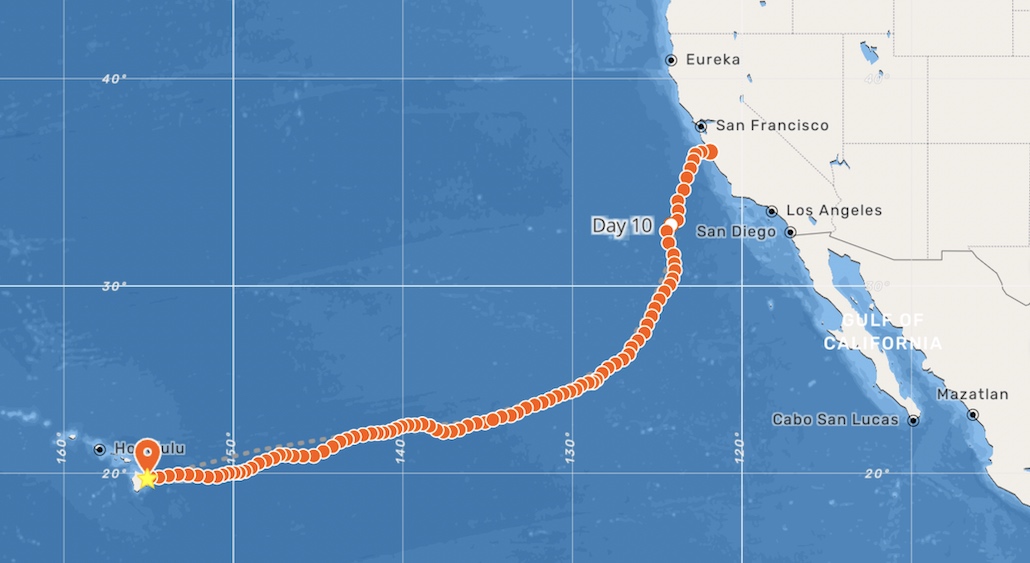
Derreumaux paddled solo and unassisted 2,400 miles from California to Hilo, Hawaii.
You’re out there by yourself, but as you say you’re not completely alone because you had your support team and people following your adventure. Did you have a sense of connection with the people who were wishing you well, thinking about you every day?
Yes, so here’s the thing – last year when I did the first attempt, I contacted all the media that I could. I had a really good press release, the pictures were ready on the day of departure and there were three TVs interviewing me. I felt it’s what I have to do if I want to be in an adventurer – I have to have media coverage, so then I have eyeballs and I can have sponsors at the back end of that.
But six days later, when I had to be rescued https://www.theguardian.com/us-news/2021/jun/07/kayaker-rescued-california-hawaii-cyril-derreumaux, pretty much the same media were really happy to say, ‘Well, this crazy Frenchman had to be rescued and this is how much it cost and who’s paying.’ And I thought, this is really detrimental to understanding why I had to be rescued.
Another realization is that I received positive support from so many people before I left that in some ways my ego was gratified before I had proven anything. We always say the hardest part is to get to the start line, and it’s true. But you can’t consider starting as being any kind of success.
How hard was it to call for evacuation six days into your first attempt, and let go of the dream in which you’d invested everything?
When you’re in the middle of it, it’s not a big deal. It took me 15 minutes to confirm to the Coast Guard to come and get me.
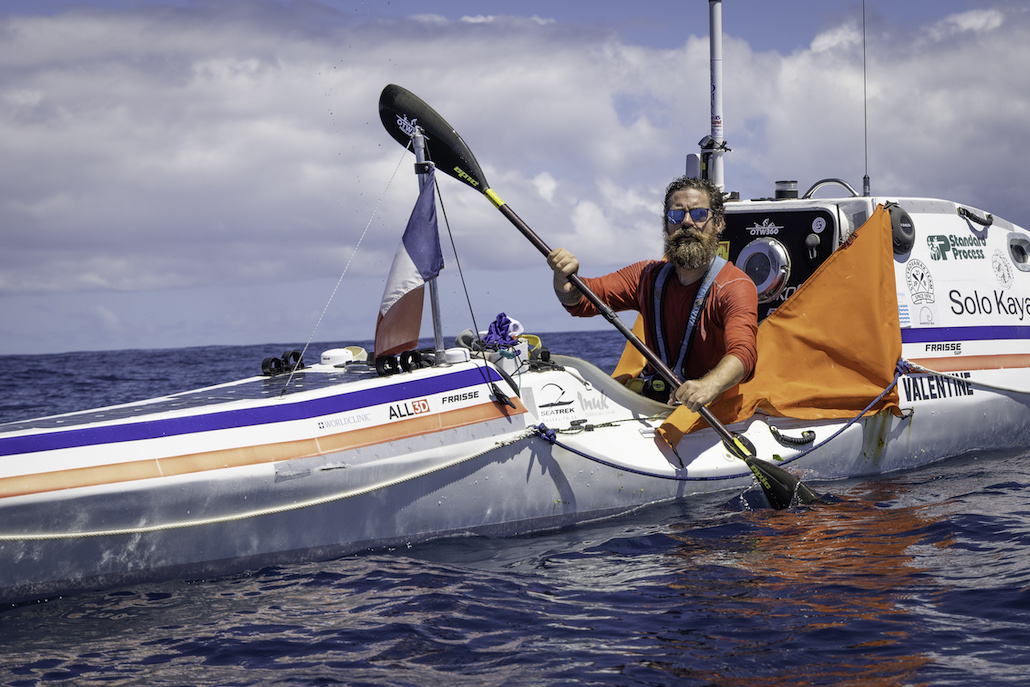
Derreumaux Training in California. Photo: Tom Gomes
How did that episode affect you? You planned to go all the way to Hawaii and only made it 70 miles. What made you decide to try again?
I really thought I was not given a fair shot. It’s really unusual to have 35 knots of wind, gusting to 45. I thought I had prepared really well, but later I had had a really good conversation with Scott Donaldson. He’s a guy who crossed the Tasman Sea from Australia to New Zealand in a kayak, and we studied what happened together.
He said, ‘Okay, Cyril, let’s start with this. Do you think you were prepared?’
‘Yeah, I started really well. I knew my gear, my communication, VHF, plotter.’
‘Yes, but you were rescued. So do you think we were prepared?’
‘Well, you know, when I got rescued, everything went well. First of all, the three days I was in the cabin, I was not afraid and I felt really safe in the boat.’
‘But you were rescued, so do you think you were prepared?
‘Yeah. When I was rescued I had all the protocols. I had my survival gear, I had the flares, I had the communication with the VHF and talking to the helicopter and all that.’
‘But Cyril, you were rescued, so were you prepared?’
‘Okay, fuck, I wasn’t prepared!’
It’s like when you have an addiction, the first thing is to realize that there’s something wrong with yourself. Although I felt at the time I was really prepared, I wasn’t. And he said, ‘Okay, let’s see how we can prepare you for the next year. And that whole year was about getting ready. Before I took any decision, I had to ask myself if it’s going to increase the probability of me being successful. Press? No. Social media? No. But sleeping more on the boat, yes. Going into rough water, yes. Doing cold water training, yes. From that moment on, I was asking myself different questions to be more prepared.
How did you get Valentine back? I’m sorry, I should pronounce it Valen-TEEN, is that right?
Yes, like my sister. She’s a dreamer like me, so I decided to call the kayak after her.
How did you get it back?
Cyril Derreumaux: I was 70 miles offshore from Santa Cruz when the Coast Guard came to get me with the helicopter and the diver. They saved my life, but they let Valentine drift. I had left the tracker aboard, so a few days later I got a tow boat in Santa Cruz and we went offshore and got it. And I could see that it weathered the storm really well.
Had I passed out for another couple of days and woken up, I would have been just fine. I could have continued. So there was something in the mental side of my preparation that I had to change. Part of that would be to trust the boat much more. It’s seaworthy like you would never believe. It’s small, but it will never break. It’s unsinkable, and self-righting if it does capsize. So I just have to trust it more. And how do I create that trust? Just by going out more in bad weather.
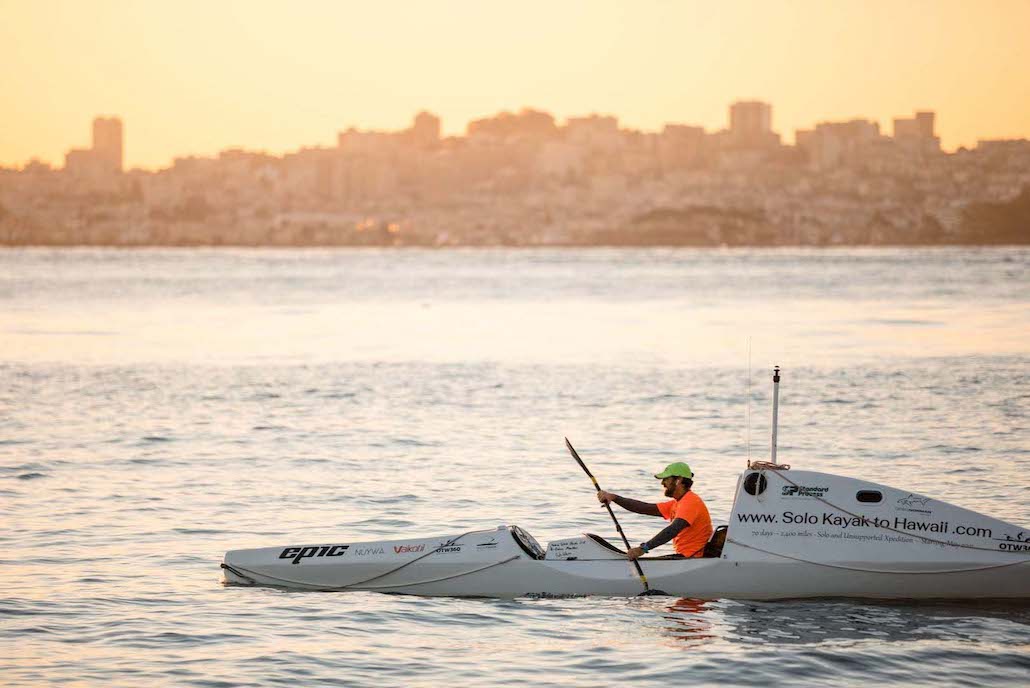
After his failed attempt in June, 2021, Derreumaux spent 12 months preparing mentally and physically for a second shot. Cyril Derreumaux via Facebook
So you did that, sleeping on the boat and seeking out tough conditions to train in?
I would start in Santa Cruz and go up the coast toward Davenport, and when the wind would pick up and I couldn’t maintain one mile per hour into the wind I would turn around and do a big downwind. I would do it four or 5 hours each day for five days, and that’s how I built confidence in my boat and essentially realized that she’s a rubber ducky. She’ll never sink. You could throw anything at her and she’ll be just fine.
In the first attempt I lived through some really hard conditions and learned what I needed to improve. I needed to have a bilge pump that can empty my cockpit very fast. I needed to be able to make satellite phone calls from inside the cabin, so I added the external antenna. And of course, I had an issue with my sea anchor. That was the reason why I went sideways in the first place.
That’s the thing about kayaks. There’s only been six or seven ocean crossings in kayaks through history, compared to rowing boats where there’s hundreds. When you talk about creating a new sea anchor, the one that was for rowing boats doesn’t work, so I needed to reinvent the wheel in some ways.
Scott Donaldson, when he crossed the Tasman Sea, it took him three times to cross. And Peter Bray took two tries for the North Atlantic. So you can read all the things you want, talk to everybody, and even cross in a rowing boat so you have the experience of the ocean, but until you’re alone on that 23-foot boat in 45-gust winds, you don’t know how to react.
So you spent all last year training and improving the boat, then tried again. How did this second trip go in the beginning?
The first week was all about managing seasickness and sleep deprivation, paddling 12 hours a day and getting as far as I could from the coast. The second week was just exhaustion. That was the hardest, because they say if something has to break, it’s going to break within two or three weeks. And it’s true—in the second week the steering lines broke and the batteries were failing. And at some point I was like, ‘Wow, this is not fair. I’ve trained so much and why?’ My team told me to sleep on it, and the next day when I was alone in the cabin, I thought if I decide to go ashore and fix all this it would take me a week to get to Los Angeles. I contemplated a little bit, and said, No way. Whatever happens on the way, I’ll just have to fix it.
That was my real departure. That’s when I started to go into a different kind of mindset. Because you have no social media, no phone, no text or calendar, no email, your mind becomes de-cluttered. And as you make one with the environment you’re able to read better the water, read the currents, know what’s happening. Then you allow yourself to drift in your thoughts, and that’s when I think I started more of a spiritual journey.
I’m very emotional, so that’s my strength. It could be also my weakness. I would say I’m missing friends and start to cry. I thought, what’s happening? Why am I so raw in my emotions? Well, it’s because I love people and everybody’s made of love. And I started to think all day about what is love in life. I wrote a blog about Love and Life, and sent it to my girlfriend, Ashley, to post it for me. She said, ‘Whoa, this is pretty deep. Are you sure you want to post that?’
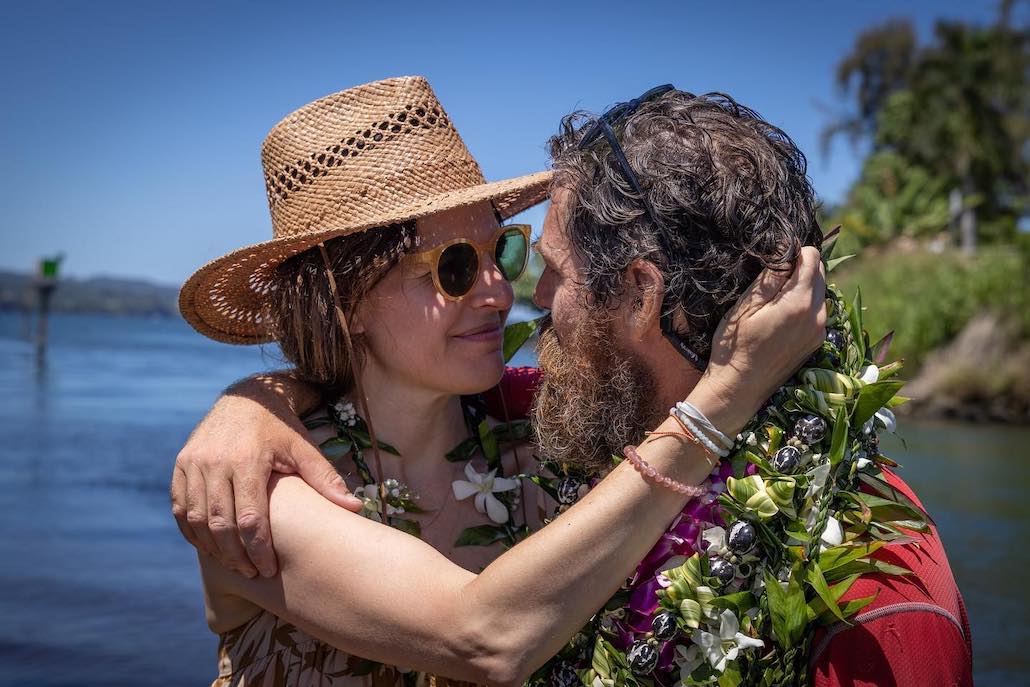
Derreumaux and his partner Ashley Redmond celebrate his arrival in Hilo, Hawaii, after a 91-day kayak voyage from California. Tom Gomes photo.
I said I might die in a week, so go ahead. And at that point, I didn’t care what people would think about it. I have to be completely honest and raw and say it. After that I wrote a blog about fraternity, and how we should all consider ourselves brothers and sisters in the same family, and we’ll make the world a better place. I rewrote the lyrics of John Lennon’s Imagine.
You were talking about the followers. My girlfriend Ashley would give me their feedback because I couldn’t go online and see what they were saying. She asked me to go deeper and keep battling and keep writing. Let’s say I had a terrible day. She would say, ‘Okay how about you change your mind by thinking what adventure means to you?’ And then the whole day I would think about what adventure is to me, and I would write the blog at night. It felt great. And then Ashley would say, ‘This person, she has to give a kidney to our sister, and she said you gave her the strength to do that. And this little kid, Logan, follows you every day and he’s 10 years old. And then I felt the strength of all these people that were following me.
Is that something that you expected?
No! No, no.
I always love to share. You never know who you are going to inspire. I think it’s also because it’s after COVID, and the world is just in pain. People are not happy with their lives. And it’s contradictory because now you can do anything you want, but people don’t do it because they’re stuck in the rat race. So I guess living vicariously through me is just freeing for people. I’m glad I’m able to do that.
We were speaking about how in the run-up to your first attempt you were trying to get as much press coverage as you could, and then you took a lower profile in the second attempt. But now this following has found you.
Yes, totally. It just felt good to be giving love away. It seems weird to say that, right? A lot of adventurers just talk about what’s going on – I’m at this longitude, these are the winds, blah, blah, blah. I took a very personal route in my blog and I shared also my spiritual journey. I did it my own way, and I think when you follow who you really are, that’s when it actually works.
Did you feel a deeper connection to the natural world when you were out there?
The connection I had with the wildlife was amazing. When you see the albatross or the birds that followed me the whole way – as the trip progressed they got much more intimate with me. It felt like they were protecting me. And then the wildlife, you see the mahi mahi hunting the flying fish, and you say, ‘Wow, those guys are so adapted to their environment.’ I haven’t seen the land in two months, and these birds are coming just to say hi. You have respect for them and how adapted they are to the world. We humans – if I don’t have water, if my water maker breaks, I’m done. It makes you realize how humans are really stupid sometimes, where we don’t respect our environment and just ruin it.
You planned on a 70-day crossing, and in the end it took you 91. Was there a sense that you were running out of food and therefore running out of time? Did you worry that you would have the Ed Gillet experience, where you’re completely out of food with days or weeks more to go?
I always felt safe. It’s my own adventure and I wanted to do it unsupported, but if it came to having a boat come to me the last week and give me food, I would do that. I had 70 days of food, but 4,000 calories a day. And I actually carried 80 days of food just to have a buffer.
When I reached the halfway point and it had taken 49 days instead of the 35 I planned, it was okay. I can manage on 3,200 calories or even 3,000 calories a day. I saved 1,000-1,200 calories per day for the 30 days remaining, so that meant I could do 95 days. We also changed the finishing point. I wanted to land in Honolulu, but if I went to Hilo instead, I would save five days because it’s 100 miles closer. So we took that decision, and the food was never really an issue.
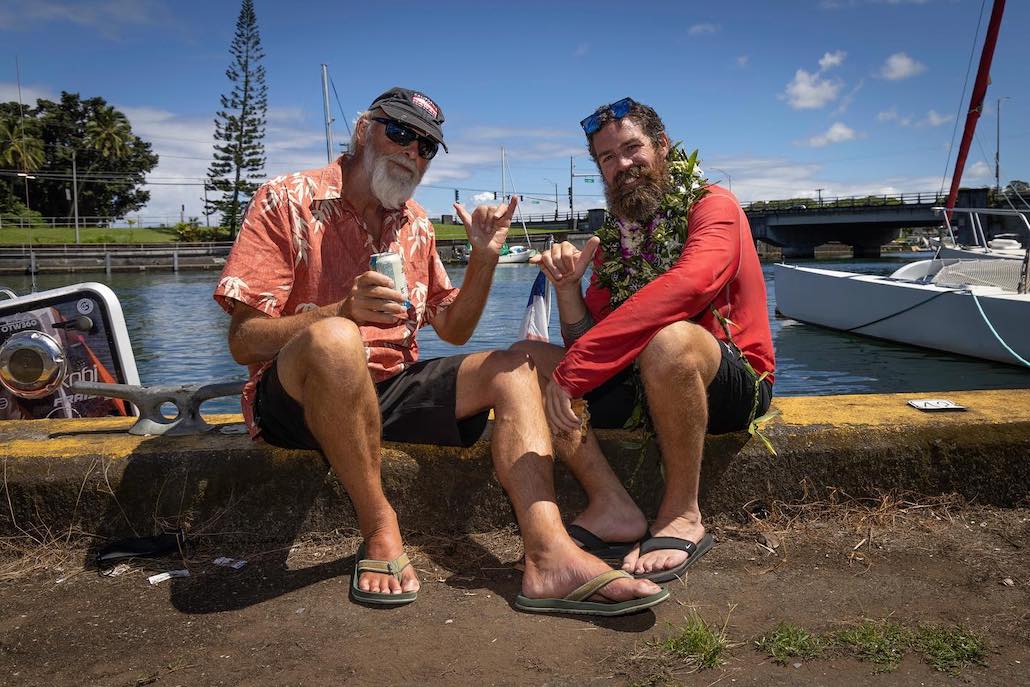
Sharing a beer in Hilo with a well-wisher. Cyril Derreumaux via Facebook
I think Ed Gillet was completely different. We talked earlier about having communication. His trip was really solo. He couldn’t speak to anybody, and he underestimated how long it would take although he had a kite to help himself and do a lot of more mileage–some days up to 70, and my maximum was 30 or 35. Even if I had to cut down to 1,500 calories a day, I would do it on survival mode. And there was no way I was quitting.
How did you deal with the boredom of paddling 10 hours a day?
I brought a lot of music. At first I would listen any time I wanted, and later on I created it as a reward. So I would only listen from 10 a.m. to 12, and then from 4 to 5:30. Sometimes I would just be happy all day with no music. I would just watch the ocean, look at nature, and be with my thoughts.
I read that you brought Seinfeld episodes along.
Yes, I had one or two episodes every night. It was fantastic. I watched all the episodes of the ninth season twice.
What Seinfeld episode most relates to paddling across an ocean?
There’s one when Elaine’s boyfriend takes them rock climbing and George drops the cord. I laughed so much! And I love the one where George is pretending to be a marine biologist, and they hit a golf ball into the whale’s blowhole.
Were there moments during this crossing when you thought you weren’t going to make it?
No, never. But didn’t take it for granted either. Especially in the last ten days where the conditions were so much better, I always was careful not to do something stupid like twist my ankle when I come out of the cabin.
There was a moment, I told you earlier, after 10 to 15 days when conditions were bad and I had to ask why is it happening to me? It’s not fair. I didn’t want to be the guy who would quit twice, and I had to be really hard on myself and just cope with my fears.
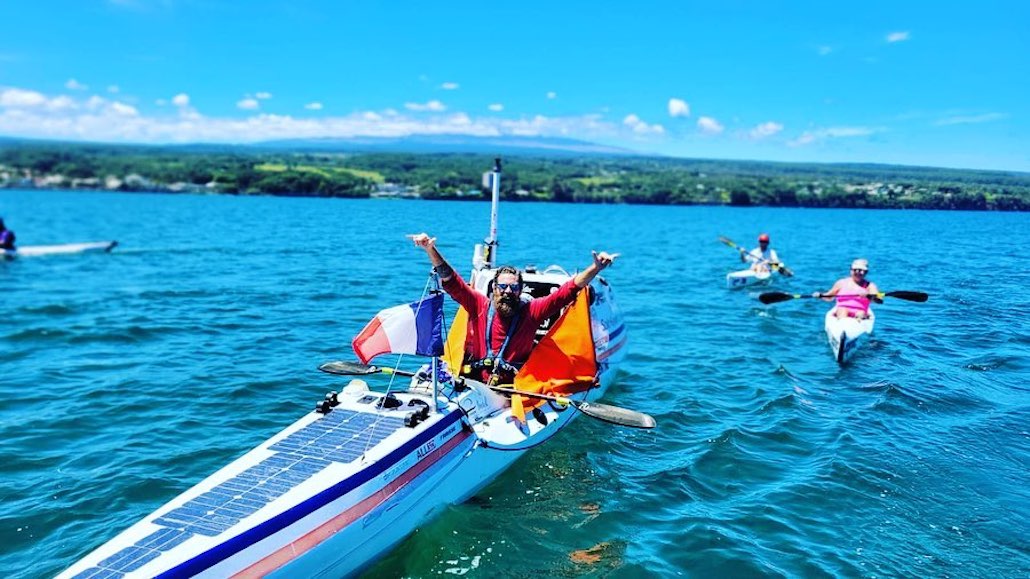
Derreumaux arrives in Hilo, Hawaii after a voyage of 91 days and nine hours.
Around the halfway point you wrote, ‘The goal of this trip has always been to paddle to Hawaii, but somewhere along the way, the goal has changed. It is now to enjoy the journey.’ How did that change in perspective help you reach both goals – enjoying the journey and completing the trip?
Before I left I thought the halfway point was going to be great, because from there it’s going to be downhill. But what happened was actually the opposite. It was like, I just did 49 days and it was so tough and now I’m going to have another 49 days like this? I felt overwhelmed. I talked about how I ate half of the elephant and I still have the second half even though I’m about to throw up. So the idea became to take one bite at a time, and reframing to say it’s not about reaching Hawaii. It’s about the journey.
Have you have you spoken to Ed Gillet since finishing?
I didn’t speak to him, but we exchanged many texts. The first one, he responded to my blog when I was on the boat. There was a point when it was really rough, and I imagined him being next to me on his boat and the conversation we would have.
I say, ‘Hey, what are you doing here?’
‘I’m going to Hawaii.’
‘Me too!’
‘What a strange idea to go in a kayak!’
‘Well, look at your boat!’
We had this conversation and then he said, ‘Keep going straight. You’re doing great,’ and when I turned around he was gone.
I posted the blog, and he responded to me on the blog — ‘Cyril, you’re doing great. I think you’re in a good way.’ Afterwards he wrote to me that he really appreciated me sharing my feelings on the day-to-day. He said, ‘I’m reliving my own adventure through yours.’ And for him it was a bit more traumatic because it was really survival. He appreciated that I’d done my homework and I finished strong, but he was the trailblazer. He showed us the way, you know.
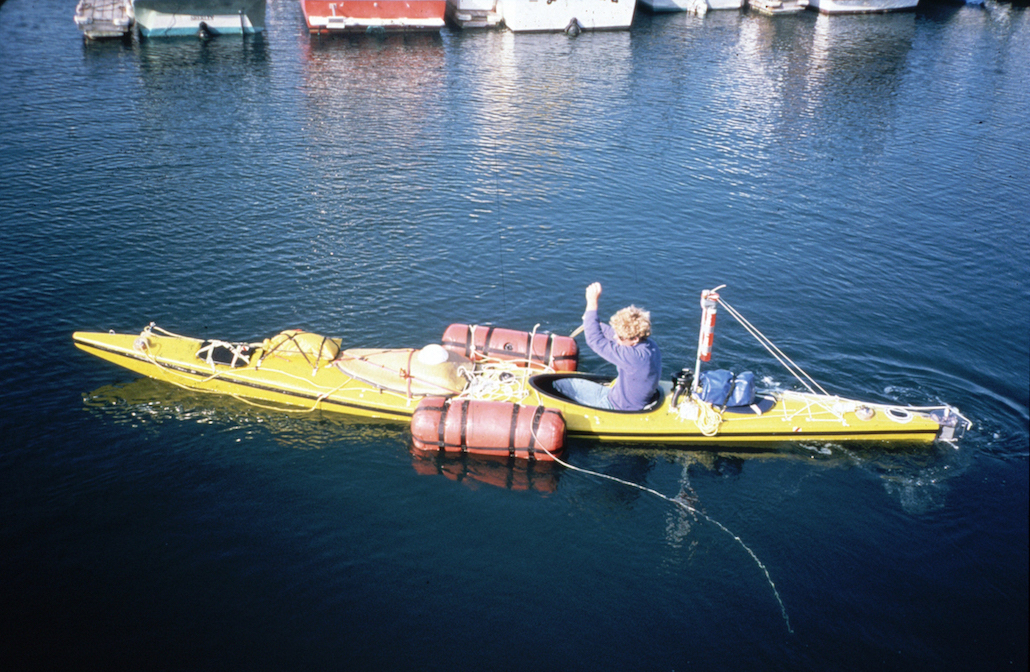
Ed Gillet testing his kayak in Monterrey, Calif. before paddling to Hawaii in 1987. He used the inflatable sponsons at night to keep the kayak upright as he slept. Ed Gillet photo
I hesitate to compare your crossing to his because that was such a different time. But what strikes me even more than the size or design of your boats is that you were able to have that contact throughout the trip, and in 1987 Gillet didn’t have that. Everybody thought he was dead until he staggered up to a phone booth on Maui and called home.
In his book, he says, ‘If I had done the trip ten times, I would have died five.’ A 50 percent chance of dying is not what I was willing to do. It’s really like bringing knives to a gunfight if you try to cross an ocean in a [standard] sea kayak. The kind of boat I have is very adapted to what we’re doing. People say it is not a kayak. Well, it’s a new category. It’s not a kayak; it’s an ocean kayak.
You’ve got Valentine on the trailer as we speak, coming home with you. What’s next? Is there going to be another voyage?
Not right away. I want to use the energy that I have right now by sharing this adventure. I’m going to do a speaking tour in January, along the whole coast of California. Let’s say I charge 20 bucks at the door. When you think of it, if you go to a restaurant, you pay 20 bucks and the next day you forgot about the meal you had. If you go to my speech you’re going to be inspired for months. I’m not going to charge anything if there’s a college or school that wants to have me speak. I will do this for free, because the youth is the future.
Nowadays if you ask a kid who is inspiring you, they’ll say Stephen Curry or LeBron James. But those guys are unreachable. They’re so far up in the sky, they’re kind of untouchable. If I go into a school, they’ll see me, a 5-foot-10, regular guy. It’s so much more accessible, and I think it’s going to change lives.
Top Photo: Tome Gomes

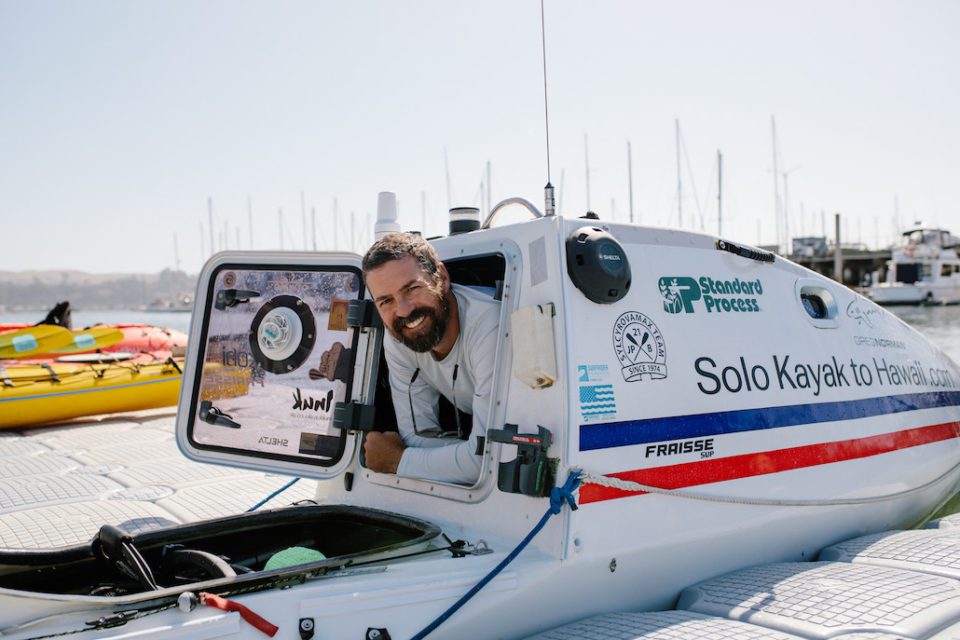
1 comment
Your article helped me a lot, is there any more related content? Thanks!